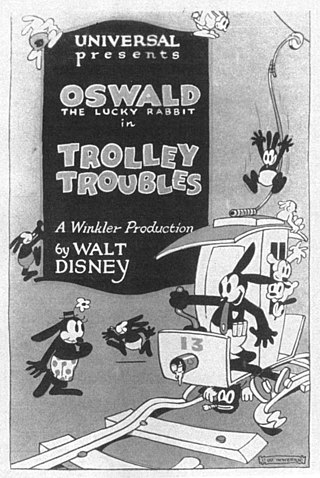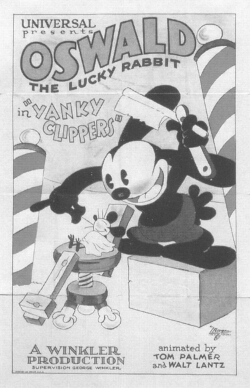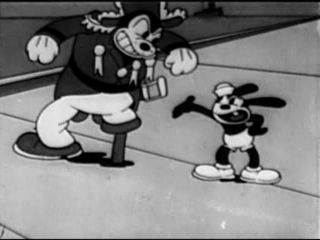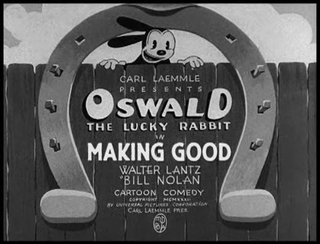Related Research Articles

Oswald the Lucky Rabbit is an animated cartoon character created in 1927 by Walt Disney and Ub Iwerks for Universal Pictures. He starred in several animated short films released to theaters from 1927 to 1938. Twenty-seven animated Oswald shorts were produced at the Walt Disney Studio. After Universal took control of Oswald's character in 1928, Disney created a new character similar in appearance to Oswald as a replacement: Mickey Mouse, who went on to become one of the most famous cartoon characters in the world.

The Alice Comedies are a series of live-action animated shorts created by Walt Disney in the 1920s, in which a live action little girl named Alice and an animated cat named Julius have adventures in an animated landscape. The shorts were the first work by what ultimately became The Walt Disney Company.

Plane Crazy is a 1929 American animated short film directed by Walt Disney and Ub Iwerks. The cartoon, released by the Walt Disney Studios, is the first finished project to feature appearances of Mickey Mouse and Minnie Mouse, and was originally a silent film. It was given a test screening to a theater audience and potential distributors on May 15, 1928. An executive from Metro-Goldwyn-Mayer saw the film, but the film failed to pick up a distributor. Later that year, Disney released Mickey's first sound cartoon, Steamboat Willie, which was an enormous success; Plane Crazy was officially released as a sound cartoon on March 17, 1929. It was the fourth Mickey film to be given a wide release after Steamboat Willie, The Gallopin' Gaucho and The Barn Dance (1929).
Charles Bear Mintz was an American film producer and distributor who assumed control over Margaret J. Winkler's Winkler Pictures after marrying her in 1924. The couple had two children, Katherine and William. Between 1925 and 1939, Mintz produced over 370 cartoon shorts.

Trolley Troubles is a 1927 animated short subject film, produced by Charles B. Mintz and George Winkler and directed by Walt Disney. The cartoon is the first appearance of Oswald the Lucky Rabbit, a character that Disney and Ub Iwerks created for Universal Pictures and Mintz.

The following is a complete list of cartoons, films, video games, etc. featuring Oswald the Lucky Rabbit created or licensed by either Universal Pictures or The Walt Disney Company. This does not include content made by external artists or studios following the character's entry into the public domain in 2023

Weary Willies is a 1929 animated short produced by George Winkler which stars Oswald the Lucky Rabbit. The film is also the penultimate Oswald cartoon created during the Winkler period.

Yanky Clippers is a 1929 silent animated short film starring Oswald the Lucky Rabbit. It is among the few shorts created during the Winkler period known to exist. The cartoon is also Oswald's last silent film.

Fiery Firemen is a 1928 silent animated short co-directed by a young Friz Freleng and Rudolf Ising, produced by George Winkler, and stars Oswald the Lucky Rabbit. It is among the few Oswald shorts from the Winkler period known to still exist.

The Navy is a 1930 short animated film produced by Walter Lantz and as part of the Oswald the Lucky Rabbit cartoons.
Oil's Well is a 1929 short animated film starring Oswald the Lucky Rabbit and produced by Walter Lantz Productions. It is the 2nd Lantz Oswald film and the 54th in the entire series.

Jungle Jingles is a 1929 animated short film produced by Winkler Productions and part of the Oswald the Lucky Rabbit series.

Ham and Eggs is a 1933 animated cartoon produced by Walter Lantz, as part of the Oswald the Lucky Rabbit series. It is the 72nd Oswald short by Lantz and the 124th in the entire series.
Beach Combers is a 1936 animated short subject by Walter Lantz Productions and features Oswald the Lucky Rabbit. It had an original copyright notice and was renewed.

The Hunter is a 1931 short animated film by Walter Lantz Productions and stars Oswald the Lucky Rabbit. It is the 48th Oswald short of the Lantz era and the 100th in the entire series.

Alpine Antics is a 1929 animated cartoon by Winkler Productions and features Oswald the Lucky Rabbit.

The Bandmaster is a 1931 short film by Walter Lantz Productions, starring Oswald the Lucky Rabbit. As with a few films from the series, the cartoon is in the public domain. A similarly titled short, also produced by Lantz in 1947, is still under copyright however.
Rollin "Ham" Clare Hamilton was an early motion picture animator. He was Walt Disney's first hire, and from 1924 to 1928, he worked as an animator for the Alice Comedies and Oswald the Lucky Rabbit shorts. In 1928, Hamilton and several other animators left the Walt Disney Studio to work at Winkler Pictures' new animation studio with the help of Charles Mintz. A year later, Hamilton briefly transferred to Walter Lantz's new studio before he helped fellow animators Hugh Harman and Rudolf Ising establish their own animation studio. He was one of the primary animators for the Looney Tunes and Merrie Melodies cartoons. From 1929 to 1934, he animated the Bosko character in the Harman and Ising studio.

Making Good is a 1932 animated short film by Walter Lantz Productions, starring Oswald the Lucky Rabbit. It is the 57th Oswald film by Lantz's studio and the 110th overall. The film had an original copyright notice, but it was not renewed.

Hurdy Gurdy is a 1929 animated short film which is presented by Carl Laemmle and was produced by Walter Lantz, who he and his wife would go on to make Woody Woodpecker. The film, which is animated by R.C. Hamilton, Bill Nolan and Tom Palmer, features Oswald the Lucky Rabbit, who is substituted for the organ grinder's dancer, after the original one is comically swallowed up by Oswald's bubblegum.
References
- ↑ Lenburg, Jeff (1999). The Encyclopedia of Animated Cartoons. Checkmark Books. pp. 115–116. ISBN 0-8160-3831-7.
- ↑ Catalog of Copyright Entries: Motion Pictures: 1912-1939 Copyright Office: Library of Congress, 1951: 755.
- ↑ Catalog of Copyright Entries: Motion Pictures: 1912-1939 Copyright Office: Library of Congress, 1951: 84.